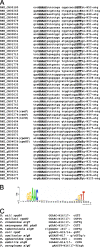Role of the extracytoplasmic function sigma factor RpoE4 in oxidative and osmotic stress responses in Rhizobium etli
- PMID: 19376852
- PMCID: PMC2698498
- DOI: 10.1128/JB.01626-08
Role of the extracytoplasmic function sigma factor RpoE4 in oxidative and osmotic stress responses in Rhizobium etli
Abstract
The aims of this study were to functionally characterize and analyze the transcriptional regulation and transcriptome of the Rhizobium etli rpoE4 gene. An R. etli rpoE4 mutant was sensitive to oxidative, saline, and osmotic stresses. Using transcriptional fusions, we determined that RpoE4 controls its own transcription and that it is negatively regulated by rseF (regulator of sigma rpoE4; CH03274), which is cotranscribed with rpoE4. rpoE4 expression was induced not only after oxidative, saline, and osmotic shocks, but also under microaerobic and stationary-phase growth conditions. The transcriptome analyses of an rpoE4 mutant and an rpoE4-overexpressing strain revealed that the RpoE4 extracytoplasmic function sigma factor regulates about 98 genes; 50 of them have the rpoE4 promoter motifs in the upstream regulatory regions. Interestingly, 16 of 38 genes upregulated in the rpoE4-overexpressing strain encode unknown putative cell envelope proteins. Other genes controlled by RpoE4 include rpoH2, CH00462, CH02434, CH03474, and xthA1, which encode proteins involved in the stress response (a heat shock sigma factor, a putative Mn-catalase, an alkylation DNA repair protein, pyridoxine phosphate oxidase, and exonuclease III, respectively), as well as several genes, such as CH01253, CH03555, and PF00247, encoding putative proteins involved in cell envelope biogenesis (a putative peptidoglycan binding protein, a cell wall degradation protein, and phospholipase D, respectively). These results suggest that rpoE4 has a relevant function in cell envelope biogenesis and that it plays a role as a general regulator in the responses to several kinds of stress.
Figures




Similar articles
-
The Rhizobium etli RpoH1 and RpoH2 sigma factors are involved in different stress responses.Microbiology (Reading). 2009 Feb;155(Pt 2):386-397. doi: 10.1099/mic.0.021428-0. Microbiology (Reading). 2009. PMID: 19202087
-
An extracytoplasmic function sigma factor acts as a general stress response regulator in Sinorhizobium meliloti.J Bacteriol. 2007 Jun;189(11):4204-16. doi: 10.1128/JB.00175-07. Epub 2007 Mar 30. J Bacteriol. 2007. PMID: 17400745 Free PMC article.
-
Stress response regulators identified through genome-wide transcriptome analysis of the (p)ppGpp-dependent response in Rhizobium etli.Genome Biol. 2011;12(2):R17. doi: 10.1186/gb-2011-12-2-r17. Epub 2011 Feb 16. Genome Biol. 2011. PMID: 21324192 Free PMC article.
-
Regulatory role of Rhizobium etli CNPAF512 fnrN during symbiosis.Appl Environ Microbiol. 2004 Mar;70(3):1287-96. doi: 10.1128/AEM.70.3.1287-1296.2004. Appl Environ Microbiol. 2004. PMID: 15006745 Free PMC article.
-
The extracytoplasmic function (ECF) sigma factors.Adv Microb Physiol. 2002;46:47-110. doi: 10.1016/s0065-2911(02)46002-x. Adv Microb Physiol. 2002. PMID: 12073657 Review.
Cited by
-
Complex two-component signaling regulates the general stress response in Alphaproteobacteria.Proc Natl Acad Sci U S A. 2014 Dec 2;111(48):E5196-204. doi: 10.1073/pnas.1410095111. Epub 2014 Nov 17. Proc Natl Acad Sci U S A. 2014. PMID: 25404331 Free PMC article.
-
Complex general stress response regulation in Sphingomonas melonis Fr1 revealed by transcriptional analyses.Sci Rep. 2019 Jun 28;9(1):9404. doi: 10.1038/s41598-019-45788-7. Sci Rep. 2019. PMID: 31253827 Free PMC article.
-
CrdR function in a curdlan-producing Agrobacterium sp. ATCC31749 strain.BMC Microbiol. 2015 Feb 10;15(1):25. doi: 10.1186/s12866-015-0356-1. BMC Microbiol. 2015. PMID: 25880528 Free PMC article.
-
Transcriptomic Changes in Medicago truncatula and Lotus japonicus Root Nodules during Drought Stress.Int J Mol Sci. 2019 Mar 9;20(5):1204. doi: 10.3390/ijms20051204. Int J Mol Sci. 2019. PMID: 30857310 Free PMC article.
-
Reactive oxygen species-inducible ECF σ factors of Bradyrhizobium japonicum.PLoS One. 2012;7(8):e43421. doi: 10.1371/journal.pone.0043421. Epub 2012 Aug 16. PLoS One. 2012. PMID: 22916258 Free PMC article.
References
-
- Akbar, S., S. Lee, S. Boylan, and C. Price. 1999. Two genes from Bacillus subtilis under the sole control of the general stress transcription factor sigma B. Microbiology 1451069-1078. - PubMed
-
- Alba, B. M., and C. A. Gross. 2004. Regulation of the Escherichia coli σE-dependent envelope stress response. Mol. Microbiol. 52613-619. - PubMed
-
- Alvarez-Martinez, C. E., R. F. Lourenço, R. L. Baldini, M. T. Laub, and S. L. Gomes. 2007. The ECF sigma factor σT is involved in osmotic and oxidative stress responses in Caulobacter crescentus. Mol. Microbiol. 661240-1255. - PubMed
Publication types
MeSH terms
Substances
LinkOut - more resources
Full Text Sources

